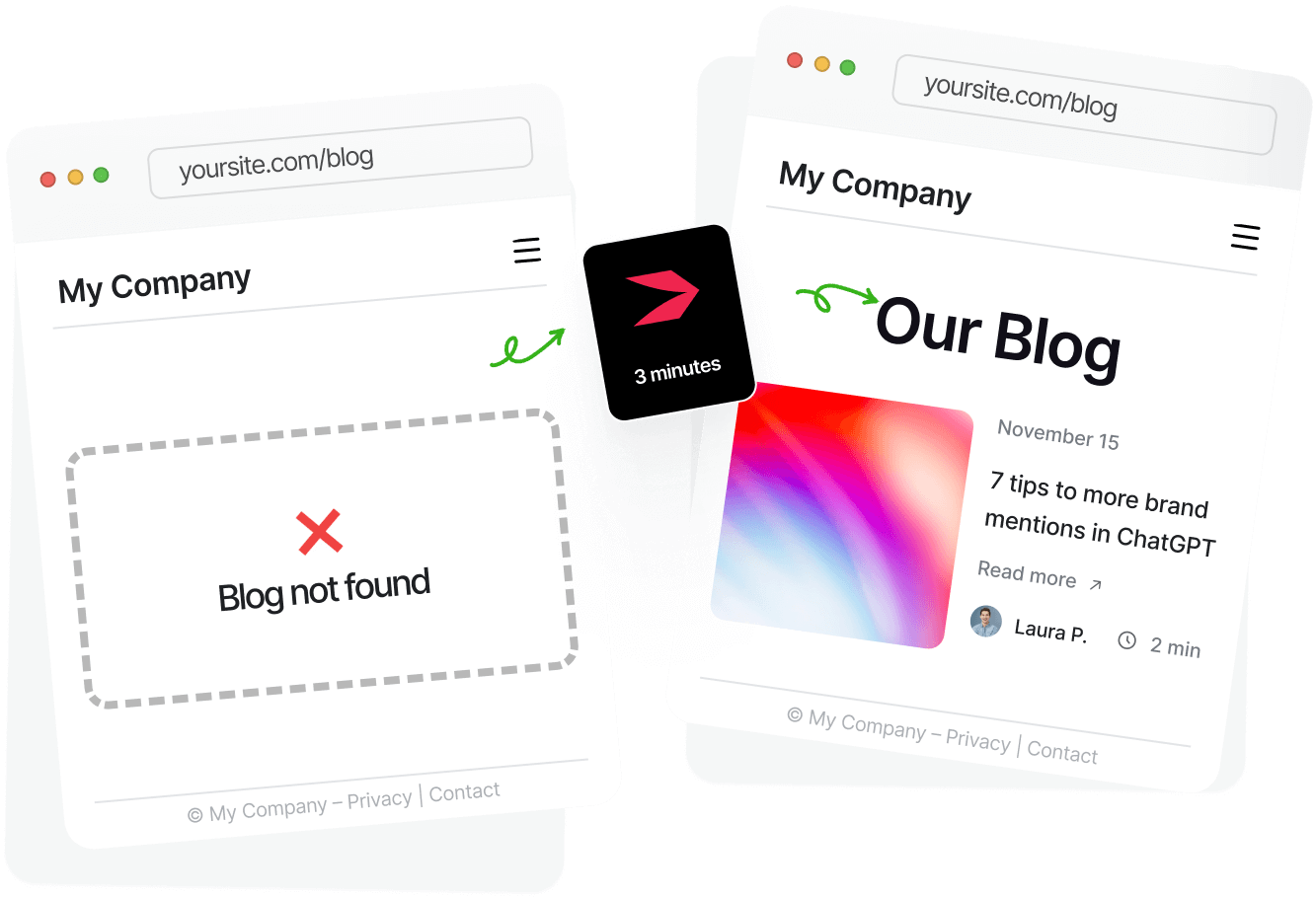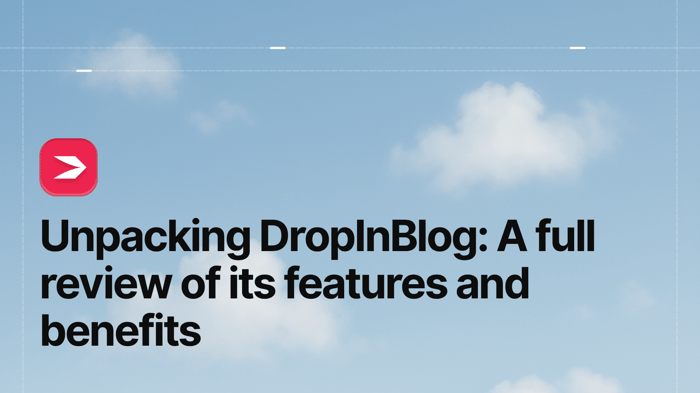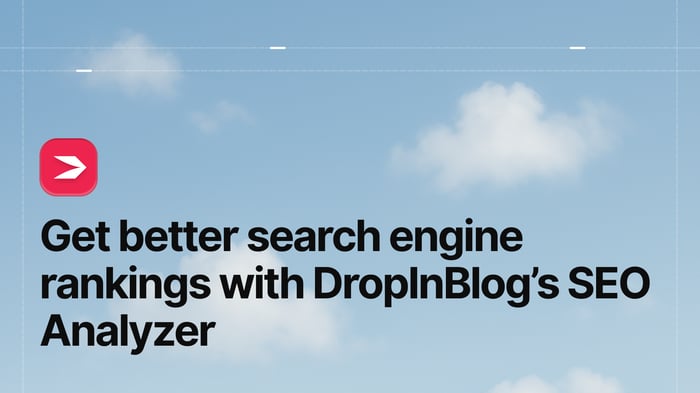Before you is a detailed guide on the best blogging platforms for small businesses, discussing the top platforms for this audience and the key features and limitations of our picks.
But do you really need a blog? Well, if you want to increase your traffic, leads, and revenue, you do need one. According to the latest blogging statistics, adding a blog to your site can increase your site traffic by 55% and grow your leads by 67% – both of which lead to higher revenue.
However, not just any blog will do. You need a blogging platform with features to engage your readers while helping you stay within your budget.
We found seven solutions that fit that description, and we’ll help you select the best one for your business.
Table of Contents
- Key Considerations for Small Business Blogging Platforms
- Top Blogging Platforms for Small Businesses
- Best Blogging Platforms for Small Businesses Compared
- Best Blogging Platforms by Use Case
- Why DropInBlog Stands Out for Small Businesses
- LitJoy Crate
- Choose the Right Blogging Platform for Your Small Business
Key Considerations for Small Business Blogging Platforms
When evaluating a blogging platform for your small business, keep these factors in mind:
Ease of use: Look for platforms that offer simple setup and a user-friendly editor – ideally something you can launch in under 30 minutes.
Affordability and scalability: Choose a platform with predictable pricing and room to grow. Watch out for add-on costs or feature caps that may limit your blog’s future.
SEO tools: 96.55% of all sites get no traffic from Google, so basic SEO features like metadata, custom URLs, and internal linking are a must. Bonus points for advanced features like keyword tracking or image optimization.
Integrations: Ensure compatibility with essential tools you already use – such as CRM, analytics, and email marketing software.
Design flexibility: Opt for a platform that lets you customize your blog’s look to match your brand – with or without code.
Top Blogging Platforms for Small Businesses
We’ve evaluated dozens of blogging platforms based on ease of use, SEO tools, pricing, scalability, and integration capabilities. Below are the top seven platforms we recommend for small businesses, each with a different focus and set of strengths.
1. DropInBlog (Best for Most Users)
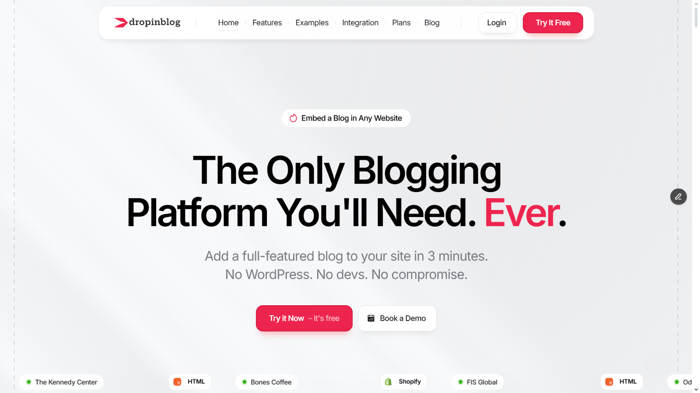
DropInBlog is a flexible, easy-to-use blogging tool. Unlike other blogging platforms on this list, DropInBlog works with (almost) any site. You don’t have to separate your blog from your primary site – just embed a blog into what you already use.
DropInBlog Key Features
Easy to set up and use: DropInBlog is a beginner-friendly platform with advanced blogging features. You can start your first blog post as soon as you sign up for an account and go through the 3-minute blog setup.
Supports the elements that make a great blog post: The blogging platform lets you easily insert videos, images, tables, a table of contents, and, of course, text-based content – all with a single click.
Lets you easily manage your content: This small business blogging tool supports blog categories, allowing your visitors to sort your content easily. Additionally, you can filter your content using various criteria, including post status, title, and author.
It’s an SEO-friendly blogging platform: DropInBlog has a built-in SEO analysis tool that checks your content’s keyword usage, linking, and image SEO best practices in real time.
Makes product embeds simple: If you run an e-commerce business, you can use DropInBlog to insert your store’s products into your blog content. The platform has e-commerce apps for Shopify and BigCommerce, allowing you to integrate dynamic product listings into your blog seamlessly.
Lets you create audio content: The Blog Voice AI™ feature is DropInBlog’s text-to-speech engine, which automatically converts your content into audio. You can also customize the sound of your blog by selecting the voice, language, and locale.
Predictable pricing: DropInBlog has several pricing plans that include all of its blogging features. There are no additional costs for any of the supported features or overage charges.
Scalable: The blogging tool supports your growth by providing the resources you need to run a SEO-friendly, fast business blog. It caters to diverse audiences, including individuals, small businesses, agencies, and enterprises.
DropInBlog Limitations
No free plan: One of DropInBlog’s limitations is that it doesn’t have a free plan. Considering it’s a professional blogging platform with a host of features, it’s no wonder you can’t use it for free. However, you can test it with a free trial before committing to a plan.
Requires a website: Since DropInBlog is a headless CMS, you must create a website before adding a DropInBlog blog to it. The upside is that you can add DropInBlog to nearly every platform you choose for your website, whether it's a page builder or a custom-coded site.
Pros and Cons of DropInBlog
| Pros | Cons |
|---|---|
✓ Easy to use | ✗ Not a free blogging platform |
✓SEO and AI search-friendly | ✗ Requires a website |
✓ Converts text to audio | |
✓ Supports reusable content blocks | |
✓ Can be used on (almost) any website | |
✓ Supports blog authors and categories | |
✓ Inherits your site’s design automatically |
Ideal for small businesses that need a fully functional, SEO-friendly, and customizable blogging solution for their website.
2. Wix
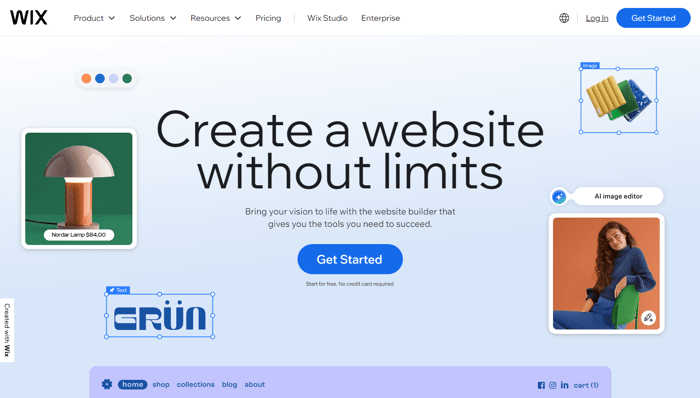
Wix is a website builder, powering over 8.1 million websites. The platform is so popular because it’s beginner-friendly. Anyone can create a blog on Wix without any technical knowledge. Meanwhile, Wix is constantly expanding its feature offer, resulting in a somewhat cluttered interface. If you can find your way around Wix’s settings and features, here’s what you can expect from its blogging tool.
Wix Key Features
All-in-one platform: Wix is one of the most widely used page builders, offering everything from site development to e-commerce to bookings. It also has its own blogging engine.
An SEO assistant: Wix also qualifies as an SEO-friendly blogging platform, thanks to its native SEO tool. It checks your post’s metadata and image SEO, and with a premium plan, it also lets you track keyword usage.
A wide selection of prebuilt templates: One of Wix’s strengths is its template collection, featuring over 900 templates. Out of those 900, nearly 150 templates are designed for blogs.
Built-in analytics: The blogging solution has its own analytics tool, providing insights into your blog posts’ clicks, views, and engagement levels.
A free blogging tool: The advantage of blogging on Wix is that you can do it for free, which is welcome for tight budgets. However, keep in mind that with the free plan, many essential blog features won’t be available to you.
Wix Limitations
Design limitations: Using the platform’s editor, you can customize your blog’s color schemes, fonts, and layouts. On the other hand, once you select a template, you can’t switch it, and CSS customizations, though available, require technical knowledge.
No export tool: One of the downsides of blogging on Wix is the vendor lock-in. The platform currently doesn’t offer a way to export content from your Wix blog.
No import tool: Similar to the missing export tool, Wix lacks flexibility in content imports. So, if you’ve already created a blog on Squarespace, for example, you won’t be able to import it into Wix.
App-dependent: The Wix Marketplace features over 800 apps, which you can use to extend your blog’s functionality. However, this also means that many of its blogging features aren’t available out of the box, and adding them may eventually decrease your site's loading speed.
Slow-loading blogs: Besides Wix apps that may affect your site’s speed, many users have also reported that Wix blogs in general aren’t the fastest ones.
No text-to-speech feature: The top blogging platforms give you the option to turn your writing into audio. Wix, on the other hand, is only considering adding this feature in the future.
Managing notifications: Wix’s notification system can be quite convenient, but it’s not as customizable as it could be. So, whenever you publish a new post, all your subscribers will be notified, which might be annoying to them.
Pros and Cons of Wix
| Pros | Cons |
|---|---|
✓ Free blogging tool | ✗ Slow-loading blogs |
✓ Over 150 blog templates | ✗ No option to switch templates |
✓ Native SEO tool | ✗ Potential vendor lock-in |
✓ Author, category, and comment management support | ✗ Requires apps for extending blog functionality |
✗ Lacks text-to-speech feature | |
✗ Storage limitations (except on the Enterprise plan) |
Ideal for small businesses looking to start a blog with no investment and with basic blogging features.
3. Squarespace
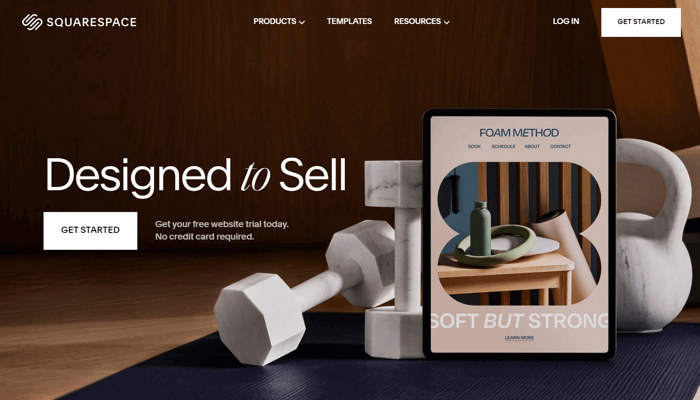
According to its users, Squarespace has the most beautiful site templates compared to other popular site builders like Wix and Weebly. It’s also one of the more beginner-friendly site-building platforms, which means that you can launch a website and a blog in a few minutes.
Squarespace Key Features
Stunning templates: Squarespace has an impressive template collection with over 450 templates across several categories. Among these templates, you’ll find 50+ professional and clean blog templates.
Various blog elements supported: The blogging platform lets you add images, accordions, videos, text, code blocks, newsletters, and many other elements to your blog content.
AI-powered tools: You can also use AI tools with Squarespace for creating blog content and generating SEO descriptions and alt text, which streamlines content production.
Image editing tool: Although simple, Squarespace has an image editing tool that supports cropping, filters, and color adjustments.
Supports design customizations: The blogging platform lets you edit CSS and customize the look of your blog to your taste. If you have some coding skills, you can make your Squarespace blog stand out.
Squarespace Limitations
Basic SEO: One of the downsides of blogging on Squarespace is that you only have access to basic SEO features. Keyword usage and internal linking practices aren’t available out of the box.
Fewer integrations compared to competitors: The platform’s marketplace has about 40 integrations, which, compared to large ecosystems like WordPress, leaves a lot to be desired.
Lacks autosave: Although it may seem rudimentary, Squarespace users must manually save their work. Otherwise, their work will be lost.
Possible site version limitations: Squarespace has two site versions – 7.0 and 7.1. The former lets you switch templates, but the features you can add to your site depend on the template you choose. The 7.1 version doesn’t let you switch templates, but at least all templates have all features.
No text-to-speech functionality: If you’re looking for more ways to engage your readers and offer your written content in an audio format, you won’t get this feature from Squarespace.
Limited import options: If you’ve already set up a blog elsewhere, you can import it into your Squarespace account. However, the supported options are WordPress, Blogger, and a few others.
No reusable blocks: Squarespace lets you add sections to your favorites, but you can’t actually make site-wide changes.
Pros and Cons of Squarespace
| Pros | Cons |
|---|---|
✓ Beautiful templates | ✗ Not a free blogging tool |
✓ Supports a host of blog elements | ✗ Basic SEO features |
✓ High level of customization | ✗ Few integrations supported |
✓ Offers an AI tool for content creation | ✗ No text-to-speech feature |
✗ Missing autosave | |
✗ Limited content import options | |
✗ Doesn’t support reusable blocks |
Ideal for small business owners who want to create beautifully designed blogs.
4. WordPress.org
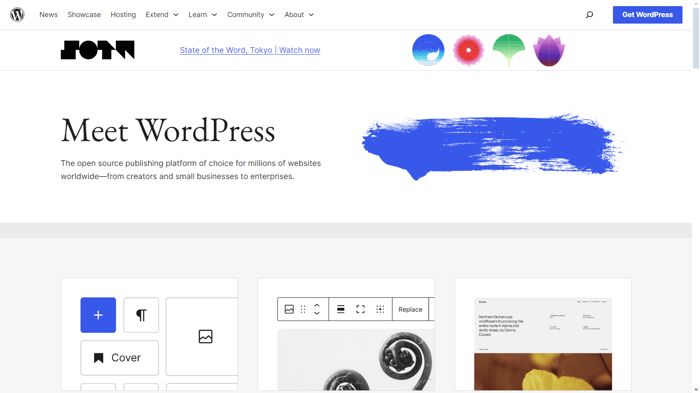
The next contender for the best blogging platform for small businesses is WordPress – the world’s most popular CMS. Keep in mind that we’ll discuss the core strengths and weaknesses of the self-hosted version, not the commercial one (.com).
WordPress Key Features
Free and open-source: WordPress is free to download, although setting up a blog on WordPress isn’t free. If nothing else, you need to purchase hosting for your blog. The open-source nature, meanwhile, means that everyone can contribute to making WordPress better.
Extensive plugin directory: There are over 59,000 plugins for WordPress sites. The directory features plugins for SEO, security, forms, e-commerce, and a wide range of other functionalities.
Highly customizable: You have complete control over your website, and if you want to make design changes, you won’t come across any restrictions, as you would with popular page builders. Again, you need some coding skills to have your site look like you want it to.
Supports teamwork: WordPress supports various user roles, allowing you to create and run your blog with your team.
WordPress Limitations
Requires technical knowledge: To create a blog on WordPress, you need to set up your hosting and have some experience working with cPanel or other control panels.
You’re in charge of your site’s technical aspects: That means you need to regularly update and back up your site, as well as ensure it’s secure.
Server restrictions: To get the most out of your WordPress site, you need to find a good hosting provider that will provide you with the necessary resources to grow your site. That includes enough bandwidth, storage space, and anything else that determines your site’s speed and availability.
Community-only support: Unlike with DropInBlog, Squarespace, or Weebly, you can’t get live chat or email support for your blog. You’ll have only a WordPress community at your disposal.
Can be expensive: Depending on your blog's desired appearance and features, the cost of running a WordPress blog can easily increase. For example, Yoast, the SEO plugin, alone costs $120/year. On top of that, you’ll have hosting costs, other plugins, and possibly design services.
Plugins slow down your blog: As good as they are, plugins take up your site’s resources. You have to balance your plugins carefully to ensure your blog loads fast.
Pros and Cons of WordPress.org
| Pros | Cons |
|---|---|
✓ Highly customizable | ✗ Steep learning curve |
✓ Full ownership of your site | ✗ Relies on plugins for adding blog functionalities |
✓ An extensive plugin directory | ✗ Community-only support |
✗ You must manage updates, backups, and security | |
✗ Possible slow loading times due to themes and plugins | |
✗ Advanced blogging features require a plugin |
Ideal for technical users who know how to set up and run a self-hosted blog.
5. Weebly
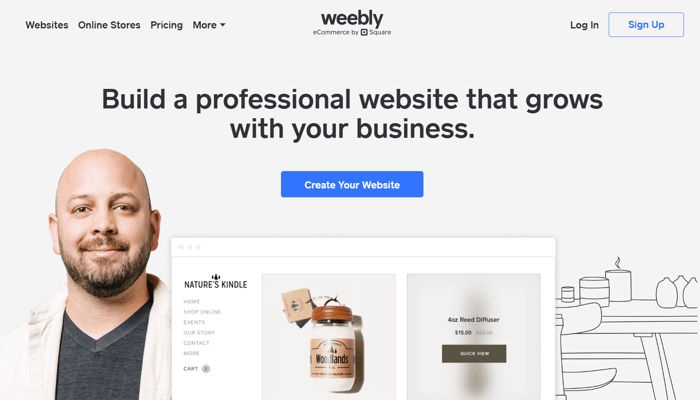
Weebly powers over 820,000 websites, and it’s one of the most frequently used site builders among freelancers, entrepreneurs, and small businesses. So, if you already have a Weebly website, you can add a blog to it, and for free.
Weebly Key Features
Easy-to-use: You can create a blog on Weebly by dragging and dropping supported elements into the editing area. While it may not be the most traditional approach to creating blogs, designing a blog page in Weebly is still pretty simple.
Supports a wide variety of blog elements: Weebly blogs support forms, products, videos, images, PDFs, and custom code. You can also display categories, feeds, and authors on your blog.
Large app marketplace: Compared to Squarespace, for example, Weebly has an impressive collection of apps you can add to your site and your blog. It currently counts 370+ apps.
External link pages: If you have a blog outside Weebly, you can easily display it on your site with the platform’s external pages. This blog integration method isn’t ideal from an SEO angle, but it’s possible.
Customizable user permissions: Weebly supports admins, editors, and dashboard-only roles, and allows you to specify which site pages your team members can access and edit.
Weebly Limitations
Infrequent updates: Since Square acquired Weebly in 2018, the site builder hasn’t received many updates. Although it’s not discontinued yet, there’s no guarantee that Weebly will remain part of the Square family.
Outdated template designs: Weebly templates look good, but compared to other blogging platforms on this list, they appear slightly less professional and less modern.
Limited free plan: You can create a blog on Weebly for free, but you won’t have access to many features, like custom domains, that will help you build a professional business blog.
Basic SEO features: In the SEO department, Weebly lets you add meta descriptions and SEO titles to your blog and individual posts. You can also customize post URLs, but that’s all.
No reusable blocks: Reusable blocks make updating content globally far easier than editing individual posts. Unfortunately, Weebly doesn’t support this feature.
No text-to-speech feature: Weebly is missing another feature, text-to-speech, which converts text to audio. You might be able to use a third-party app for this, but the feature isn’t built-in.
Pros and Cons of Weebly
| Pros | Cons |
|---|---|
✓ Easy-to-use | ✗ Basic SEO features |
✓ A free blogging tool | ✗ Infrequent updates |
✓ Supports authors, categories, and various blog elements | ✗ No text-to-speech feature |
✗ No reusable blocks | |
✗ Limited free plan |
Ideal for anyone looking for a user-friendly blogging tool with a free plan.
6. Medium
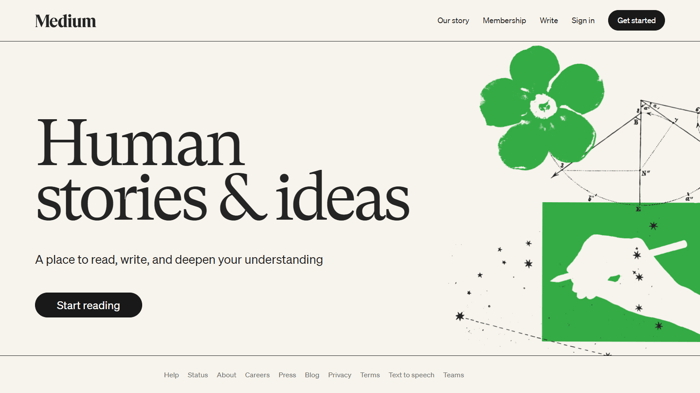
Using Medium, you can create an account on the platform and start blogging right away. You don’t need any technical knowledge to create a blog on this platform. Many big names already have a blog on Medium, including Netflix, Adobe, and PayPal. Keep in mind, however, that all these are technological blogs and often serve as a backup for the primary blog hosted on another platform.
Medium Key Features
Easy-to-use: Medium is one of the simplest blogging tools. You can access the blog editor from the Stories menu, and once you open it, you can just start typing.
Built-in analytics: The blogging platform lets you track how your content’s performing. You can see views and reads for all your stories, and gain insight into new followers and email subscribers.
Existing audience: Medium has an established readership, meaning your blog will probably be seen right away. Because there are many blogs on Medium, the competition is tough, though.
Text-to-speech feature: Your readers can listen to your blog content on Medium. This isn’t Medium’s built-in feature, but an integration with Speechify. Still, it’s a nice addition to the platform’s native features.
Medium Limitations
Limited SEO features: You can customize title tags, meta descriptions, and post URLs. Besides that, Medium doesn’t offer any other tools for optimizing your blog content.
Basic blog elements: Medium doesn’t have a lot of ready-made blocks for blogs. If you want to add a table of contents, FAQs, or lists, you’ll have to use code blocks.
Some blog elements are only available via shortcuts: If you’ve wanted to add a bullet list to your blog post and haven’t found it, you’re not alone. This feature can only be added by pressing asterisk + space.
Limited integrations: Medium only lets you connect your account to Facebook, X, and Mastodon. Compared to Wix or WordPress, which offer hundreds of third-party apps, the platform lags significantly behind its competitors.
Poor design customizations: The platform allows you to customize the header area of your profile. However, if you want to make bigger design changes or add your own CSS, you won’t have much luck with that.
No reusable blocks: If you publish your content frequently and need to update information quickly, reusable blocks are a perfect solution. Medium, however, doesn’t support this feature.
Pros and Cons of Medium
| Pros | Cons |
|---|---|
✓ Easy to use | ✗ Basic SEO options |
✓ Free blogging tool | ✗ Minimal design customizations |
✓ Built-in audience | ✗ No advanced blogging features |
✓ Text-to-speech supported | ✗ Lacks third-party integrations |
✗ No reusable blocks |
Ideal for businesses with high brand recognition as it leverages existing trust and visibility to further expand reach and authority.
7. Hostinger Website Builder
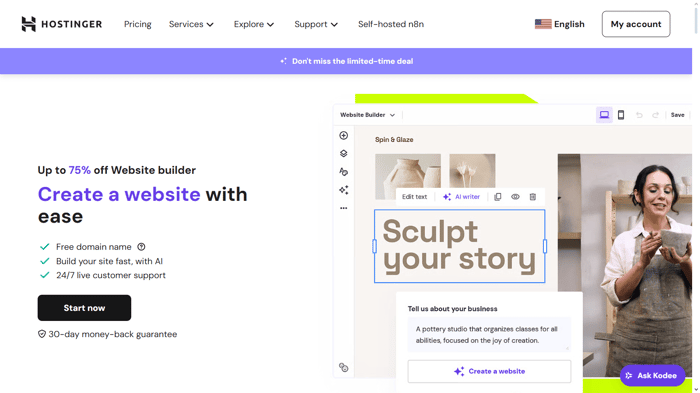
The last solution on our list of the best blogging platforms for small businesses is Hostinger Website Builder. It’s an AI-powered site creation tool with blogging functionality.
Hostinger Website Builder Key Features
Advanced SEO features: Hostinger is one of the few blogging tools with SEO features such as setting primary keywords, adding title tags and meta descriptions, and modifying URLs.
Various AI tools supported: With Hostinger’s AI Writer, you can utilize AI to write an entire blog post, setting the tone of voice and content length as needed. Additionally, the platform has an AI tool for generating images, sections, pages, and logos.
Great selection of sections: As mentioned, you can use AI to generate sections, or select one of the pre-built ones, e.g., FAQs, galleries, menus, testimonials, and forms.
E-commerce functionality: Although many platforms on this list let you create an online store, Hostinger does so seamlessly. You can add a store to your site with a single click.
Hostinger Website Builder Limitations
Limited integrations: Hostinger’s website builder integrates with about a dozen third-party tools. And even for this, you have to use code.
Some basic blog elements are missing: If you want to add a table to your blog post, you’ll have to add code to your site. If you want to enable comments, you’ll need to embed them using a third-party tool.
Limited customization: Hostinger doesn’t offer much flexibility when it comes to your blog’s design. You can change the font, colors, and buttons, but you can’t modify much else.
Restrictive free trial: The platform offers a free trial, but even during the trial, you can’t publish your blog. To see the live version, you have to purchase a subscription.
Basic user roles: If you want to collaborate with your team on your blog, you’ll only have two access levels. Also, these levels are non-customizable.
Pros and Cons of Hostinger Website Builder
| Pros | Cons |
|---|---|
✓ Supports various AI tools | ✗ Limited customizations |
✓ Advanced SEO features | ✗ No user roles in a traditional sense |
✓ Pre-built sections | ✗ Few integrations (via code) |
✗ Missing basic blog elements | |
✗ No text-to-speech feature | |
✗ No reusable blocks |
Ideal for business owners looking for a straightforward blogging tool without many customization options or advanced features.
Best Blogging Platforms for Small Businesses Compared
| Easy to integrate | SEO features | Customization options | Pricing | User support | |
|---|---|---|---|---|---|
DropInBlog | Yes | Advanced | Inherits your site’s design Design Customizer with live preview CSS edits | $49/month to $499/month | Email and live chat support |
Wix | Yes | Basic | Template-based | Free to $159/month | Email, live chat, and phone |
Squarespace | Yes | Basic | Template-based | From $25/month to $72/month | Email, chat, and community |
Wordpress | No | Plugin-dependent | Highly customizable | Between $100 and $1,000 | Community |
Weebly | Yes | Basic | Template-based | Free to $26/month | Email, live chat, and phone |
Medium | Yes | Basic | Very limited | From $5/month to $15/month | Ticketing system |
Hostinger Website Builder | Yes | Advanced | Very limited | $11.99/month to $13.99/month | Email and live chat |
Best Blogging Platforms by Use Case
Not all small businesses have the same needs. Whether you’re running a solo consultancy, launching a store, or building a personal brand, here’s a quick breakdown of which platform may suit you best.
E-commerce stores | DropInBlog | Dedicated blogging apps for Shopify, Big CartelBigCommerce, product embeds, and SEO features tailored for online stores. |
Solopreneurs | DropInBlog or Squarespace | Visually stunning templates and an intuitive editor – perfect for consultants, coaches, creatives, and solopreneurs. |
Budget blogging | Wix or Weebly | Free plans available with basic functionality, ideal for businesses that are just starting out. |
Total control and customization | WordPress.org | Full ownership, limitless plugin ecosystem, and deep customization – great for technically savvy users or developers. |
Minimalist, no-fuss blogging | Medium | Quick setup and built-in audience – best for thought leadership without managing a full website. |
AI-powered simplicity | Hostinger | Built-in AI tools for content creation and design, with a low learning curve and modern interface. |
Why DropInBlog Stands Out for Small Businesses
After comparing the notable features and limitations of these seven blogging platforms for small businesses, DropInBlog stood out as the best solution for most small businesses. Here’s why:
Seamless integration with various website platforms: If you already have a website on WordPress or Kartra, don’t worry. You can add a DropInBlog blog to it in 3 minutes.
Built-in SEO Analyzer: Enter your primary keyword and see your SEO score change in real-time as you implement the keyword into your content. The platform’s SEO analysis tool also checks your content for internal links, alt text, and heading structure.
Role-based access controls for team collaboration: If you have a team of writers, editors, and designers, you can use DropInBlog’s user levels to make sure everyone has the right access to your content.
Platform-agnostic design that inherits existing website styles: It doesn’t matter where you created your website – DropInBlog fits right in with your existing design. You don’t have to do anything to match the style of your site and blog because DropInBlog does this automatically.
LitJoy Crate
We've been using DropIn Blog for couple of years ... The app just gets better and better, which means they care, and I'm here for that!

Choose the Right Blogging Platform for Your Small Business
Once you've found a platform that meets your requirements, set up your blog. Otherwise, you’ll be behind 80% of businesses that already use their blog for marketing and lead generation.
If you’re still unsure about the best option for your requirements, here’s a quick summary of the features you should get from your blogging tool:
Simple setup that takes minutes to complete
SEO tools to make your blog visible in online searches
Design flexibility to help you match your blog’s style with other site pages
Intuitive editor with a wide selection of blog elements to help you create engaging, high-converting blog posts
No-code table of contents, FAQ builder, product embeds, and call-to-action buttons
Reusable blocks of content for straightforward content updates
Scalability – your blog needs to grow along with your business
DropInBlog offers all these features, eliminating the need for third-party apps to access advanced blogging capabilities. You can try it for free and see for yourself how easy (and profitable) blogging can be.
If you have any questions, we’re here to help. Reach out to us at any time.
Happy blogging!


